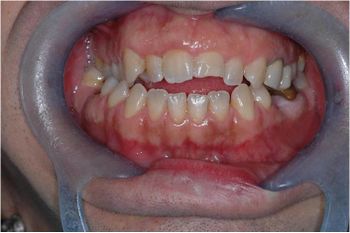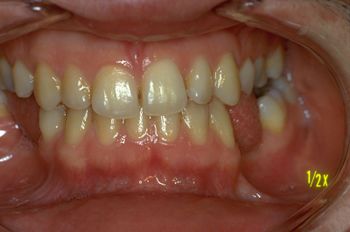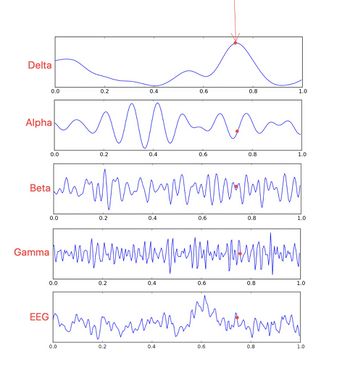Logic of medical language: Introduction to quantum-like probability in the masticatory sys it
| Other languages: |
A volte pensiamo: 'La realtà profonda di uno 'Stato di sistema' può essere ridotta solo a un'osservazione macroscopica che da ora chiameremo 'Osservabile' se un sistema così complesso è un insieme di Stati misti? Inoltre, la condivisione di un'interpretazione come può essere "Normocclusione o Malocclusione" attraverso una descrizione statistica classica non ha nulla a che vedere con un'interpretazione quantistica della realtà perché nel classico si osservano fenomeni macroscopici (movimenti mandibolari, ATM, ecc.) mentre in una realtà quantistica abbiamo a che fare con fenomeni mesoscopici com, per esempio le trasmissioni sinaptiche.
Questa mentalità deterministica (causa/effetto) potrebbe essere trasformata in un modello formale che impieghi la matematica di tipo quantistico ed essere in grado di investigare la dinamica stocastica mesoscopica della biologia ed in particolare, nel nostro caso, del sistema masticatorio? Cercheremo di approfondire questo argomento che è solo apparentemente criticabile ma che in fondo dipende tutto dall'incapacità di accettare il cambiamento mentale.
Introduction
Per la seconda volta ci troviamo di fronte ad uno studio epistemologico di un tema su cui si basano la maggior parte delle discipline riabilitative odontoiatriche, quello della 'Malocclusione' che alla luce di quanto detto nei capitoli precedenti merita un chiarimento.
Nel primo capitolo 'Introduzione' abbiamo già citato il paziente in figura 1 in cui sarebbe irriverente nei confronti della disciplina ortodontica non considerare uno stato di 'Malocclusione' ma in qualche modo abbiamo anche messo in discussione l'Informazione assiomatica' sostituendo il classico dogma ortodontico con una visione neurofisiologica dello stato del sistema del paziente. Da questo approccio era chiaro che la realtà mesoscopica è molto diversa dalla realtà macroscopica a cui siamo abituati far riferimento in pratica la clinica è infinitamente distante dai processi mesoscopici attivi in un dato tempo in cui si fa diagnosi.
Ma se si tratta di un'anomalia, allora, cosa dobbiamo aspettarci dal paziente in figura 2 sottoposto a chirurgia ortognatica (leggi didascalia descrittiva)?
Questo dato indica una severa 'Malocclusione' anche se le relazioni intermascellari appaiono oggettivamente in una condizione occlusalmente più congrua rispetto a quella del paziente n° 1 in figura 1.
Detto questo, ci viene da pensare:
'La realtà profonda di uno 'Stato di Sistema' può essere ridotta solo ad un'osservazione macroscopica (Osservabile) se tale 'Sistema Complesso' è un insieme di stati misti? Inoltre, la condivisione di un'interpretazione di "Normocclusione o Malocclusione" attraverso una descrizione statistica classica non ha nulla a che vedere con un'interpretazione quantistica della realtà perché nel classico si osservano fenomeni macroscopici (movimenti mandibolari, ATM, ecc.) mentre in una realtà quantistici abbiamo a che fare, come già detto, con fenomeni mesoscopici quali le trasmissioni sinaptiche, il potenziale d'azione, i dipoli le corrente ioniche ecc..
Ecco un argomento molto stravagante e rischioso ma contestualmente significativo, ciò che in fisica quantistica viene chiamato 'Sovrapposizione di Stati' in un Sistema.
(Ovviamente vi soddisferò subito spiegandovi il paradosso del gatto di Schrödinger)
Il gatto di Schrödinger
La "filosofia" della sovrapposizione di stati quantistici
Nel 1935 Erwin Schrödinger:[1][2] per evidenziare i risultati paradossali dell'interpretazione di Copenaghen propone un esperimento immaginario in cui un gatto viene posto in una scatola contenente una fiala sigillata con del veleno. Grazie a un meccanismo ben costruito, la fiala potrebbe rompersi. La figura 3 rappresenta graficamente il dispositivo immaginario appena esposto. Per comprendere meglio il significato di questo riferimento al quantistico, riportiamo uno specifico contenuto estratto da Wikipedia.[3]
Un gatto viene rinchiuso in una cassa d'acciaio insieme alla seguente macchina infernale (che va protetta dalla possibilità di essere afferrato direttamente dal gatto): in un contatore Geiger c'è una minuscola porzione di sostanza radioattiva, così poca che nel corso di un ora forse uno dei suoi atomi si disintegrerà, ma anche, altrettanto probabile, nessuno; se l'evento si verifica, il contatore lo segnala ed aziona un relè di un martello che rompe una fiala di cianuro. Dopo aver lasciato indisturbato per un'ora tutto questo sistema, sembrerebbe che il gatto sia ancora vivo se nel frattempo nessun atomo si fosse disintegrato, mentre la prima disintegrazione atomica lo avrebbe avvelenato.
La funzione matematica dell'intero sistema porta ad affermare che in esso il gatto vivo e il gatto morto non sono stati puri, ma mescolati con uguale peso[4]
(Sono curioso di sapere dove vuoi andare)
Spesso il risultato dell'esperimento viene presentato nei seguenti termini. Dopo un intervallo pari all'emivita, l'atomo può essere decaduto o meno con la stessa probabilità, quindi è in una sovrapposizione dei due stati: nella notazione di Dirac, lo stato dell'atomo è:
Iniziamo ad utilizzare nozioni di matematica quantistica, infatti l'acronimo sta per 'ket'[5]
Ma poiché il decadimento determina il destino del gatto, dovrebbe essere considerato sia vivo che morto:
almeno fino a quando non si effettua una 'Osservazione diretta' aprendo la scatola. Qui va ricordato che l'osservazione diretta consiste in un osservatore e in uno strumento di misura.
L'apparente paradosso nasce dal fatto che in meccanica quantistica non è possibile descrivere classicamente gli oggetti e si usa una rappresentazione probabilistica: per mostrare il fatto che una particella può essere posta in diverse posizioni, ad esempio, è descritta come se fossero contemporaneamente in tutte le posizioni che essa può assumere. Ad ogni posizione possibile corrisponde una probabilità che osservando la particella si trovi proprio in quella posizione. L'operazione di osservazione, però, modifica irrimediabilmente il sistema in quanto una volta osservata in una posizione la particella assume definitivamente quella posizione (cioè ha probabilità 1 di esserci) e quindi non è più in una "sovrapposizione di stati".
Tornando al caso del gatto, però, va precisato che la descrizione di cui sopra non è corretta.[6] La stessa conclusione di Schrödinger, che tuttavia non usa mai il termine "paradosso", si esprime in termini molto diversi: Schrödinger si riferisce alla funzione d'onda dell'intero sistema, non a quella del gatto. Infatti, la teoria quantistica afferma che il sistema atomo + gatto è descritto dallo stato di correlazione quantistica.
It is therefore not correct to say that the cat is in a superposition of two states, because the superposition affects the entire system [7]. The fundamental difference is that the two subsystems, i.e. the atom and the cat taken individually, are rather described by a statistical mixture [8]. The uncertainty about the fate of the cat is "classic": it is alive or dead with a probability of 50%, without any interference between the two different states.
The perplexity expressed by Schrödinger lies in the fact that quantum mechanics is apparently also applicable to a living being, which can find itself in a state of quantum correlation ( entanglement ) with a particle. It is therefore legitimate to ask whether even a macroscopic object should obey the laws of quantum mechanics, without the possibility of verifying its effects at an experimental level.
Schrödinger described the previously described diabolical device whereby a feline would become entangled with a single atom. The system would be described by a wave function, commonly abbreviated with , which represents, at the same time, the live cat with the excited atom and the dead cat with the atom returned to the state fundamental, after its decay triggered the lethal device. Quantum physics experts will object that the cat is an open complex system, which cannot, even at the start of the cruel experiment, be described by a wave function. The reasoning, however, raises an important question: Why, and how, does the weirdness of the quantum world disappear in macroscopic systems?[9]
The peculiarity is that the breaking of the vial is determined by the decay of particles (process subject to quantum rules). Quantum rules (microscopic particles) are very different from those of macroscopic physics: with this thought experiment, however, it was possible to have the cat's life conditioned by quantum rules.
It is interesting to see how Schrödinger managed to create with an imaginary experiment to involve the consequences of quantum theory to the macrospic world represented by the cat.
The mathematical ormalis
The cat experiment is connected, as mentioned, to the problem of measurement. A quantum system is in a superposition of two states and (mathematically represented by the 'ket' ); an observation of it forces the system to go definitively or in the or in the . The presence of the cat causes the superposition in which the atom is found to be "transferred" to the overall system (atom + cat). The atom, therefore, is no longer in a superposition, just as the cat is not.From this first presentation we understand the meaning of the argument
The only way to understand the condition of the cat remains to open the box and check if the cyanide ampoule is broken and consequently the cat is dead.
The formula representing this situation is the following:
which can be read in the following way: the wave function over time is the same as ket and the cat is alive
A state that will then evolve in a time period in which (except for phase and normalization factors) the two states in , (due to the observer's ignorance?) , coexist:
What will collapse state into one or only ?
Leaving aside the various interpretations, for orthodox thought the collapse will be caused by the interaction with a macroscopic measuring object, that is when this 'Observable' is observed by the observer. We have therefore generated a (observable) System comprising the physical State of the System itself, an observer and a measuring instrument.
To be precise, the formula is incomplete, you need to multiply each term to the right of the equation with a number. The number indicates the 'probability' that the specific event will occur, the complete formula will be:
The number indicates the probability (square rooted) that the specific event will occur.
Let's take an example that brings us back to the medical field:
if the event has a 50% chance of occurring and the event has 50% to occur then the formula becomes (unless phase factors)
which in more exact terms mathematically turns into
(yes of course it's simpler than you think)
Let's imagine that an 'Observable' is the human brain that from a purely symbolic point of view could represent Schrödinger's cat box, given that the skull contains an organ of such excellent functionality.
At this point, in the absence of particular symptoms and clinical signs, we can say that the subject is healthy. In practice we have done nothing but say the same thing that can be said about Schrödinger's cat box and that is that 50% of the cat is alive (healthy subject) and 50% could be dead (sick subject).
Take into account the subtlety of Schrödinger's metaphor because most people belittle the concept by reducing everything to a naive logic in which the cat was already dead even before opening the box and my 6-year-old nephew would have reached this point too.Schrödinger's real metaphorical sense does not refer directly to the cat (macroscopic structure) but to the uranium atom (microscopic structure) which decays (dead cat) with a random temporal probability implying that the cat's life is linked to the temporal random probability of the decay of uranium. In short, the interpretation that derives from the macroscopic observable would be a selective filter that delays the interpretation of the microscopic observable, which means that the absence of symptoms could be a phenomenon dampened by the macromolecular filter.
In this sense, from the moment in which the uranium, following its own random decay process, activates the hammer that breaks the ampoule and the cyanide spreads into the box. The time elapsing from the decay to the actual death of the cat corresponds to the superposition of states and if we wanted to make a provocative comparison we can think of time occurring in the oncogenic mutation of BRAFin melanoma.
This is the superposition of states and the collapse of the wave function (dead or alive cat) corresponds to a mainly quantum dialectic.
Returning to our example, to understand if the subject actually, even better the subject's brain is intact or unstructured (the term healthy or sick is still a further step) we should open the box and see inside the state of the Central Nervous System.
Not even Schrödinger would have used this metaphor so we invented measuring instruments .... fantastic !!!
(it is not so much what it measures but how the measure is interpreted)
Electroencephalography (EEG)
To stay on the neurophysiological theme, let's consider EEG electroencephalography. The measuring instrument basically measures nothing more than the difference in ionic electric potential 'dipole' that moves at sustained speeds here and there between the neural interconnections (Lagrangian coordinates) [10]). Figure 4
Well, here we introduce the quantum-like concept: if we observe the state of the brain through an EEG measurement we can only say that in a situation of this type the EEG state is nothing more than a superposition of mixed states which are essentially at least the 5 frequencies of wave depicted in figure 4. (EEG trace)
With this measurement (if we consider the EEG trace at the bottom of Figure 4) it remains very difficult to extrapolate the real condition of integrity of a specific and restricted brain area even supported by sophisticated mathematical / statistical analysis methods such as Fourier transforms, Wavelets etc., because the uncertainty of the measurement increases considerably in relation to the measured volume amplitude, the neuronal discharge rate, the sampling frequency, etc.
The EEG is not only the result of a tonic activity of the neuronal pool but a space-time sum of synchronous (phasic) and asynchronous (tonic) neuronal activities which sometimes collide, canceling, among other things, parts of the EEG trace.
Unfortunately in the EEG measurement we have a form of uncertainty of the measurement data. This phenomenon has been defined as the analogous 'Heisenberg Indetermination' principle of the form, in which stands for uncertainty constant of the electroencephalographic measurement. The authors of this study[11] found that their quantum-like model leads to a minimum value of uncertainty constant in eand in of in the case of the EEG. ( see chapter 'Exploring electroencephalography with a model inspired by quantum mechanics'.
At this point we have two 'Observables' in an asymptomatic subject tested in time the one deriving from the system measurement '' (EEG) which from what has been said could return a data system integrity (data polluted by ) and an observable ''' corresponding to the state of health of the subject who turns out to be sick.
The reality observed according to this projection would make the two observables and incompatible.
In textbooks on quantum mechanics, it is commonly pointed out that the main distinguishing feature of quantum theory is the presence of 'incompatible observables'. Recall that two observables, as in our case, e , are incompatible if it is impossible to attribute joint values to them. In the probabilistic model, this leads to the impossibility of determining their 'joint probability' distribution (JPD). (see chapter 'Quantum-like modeling in biology with open quantum systems and instruments')
(.... we will see in the next chapters how the approach changes)
- ↑ Milton Packer. The Parable of Schrödinger's Cat and the Illusion of Statistical Significance in Clinical Trials. . Circulation. . 2019 Sep 9;140(10):799-800doi: 10.1161/CIRCULATIONAHA.
- ↑ Carlos E Rochitte. Cardiac MRI and CT: the eyes to visualize coronary arterial disease and their effect on the prognosis explained by the Schrödinger's cat paradox. Radiol Bras..Jan-Feb 2016;49(1):VII-VIII. doi: 10.1590/0100-3984.2016.49.1e2.
- ↑ Schrödinger's cat paradox
- ↑ Schrödinger, Erwin (November 1935). "Die gegenwärtige Situation in der Quantenmechanik (The present situation in quantum mechanics)". Naturwissenschaften. 23 (48): 807–812.
- ↑ Notation bra-ket
- ↑ Stefan Rinner, Ernst Werner: On the role of entanglement in Schrödinger's cat paradox, Central European Journal of Physics 02/2008; 6(1):178-183
- ↑ In fact, the apparatus imagined by Schrödinger is even more complex, because it does not simply include an atom and a cat . To be precise, the other elements, such as the Geiger counter and the cyanide vial, should also be considered, which are also macroscopic. But even with this addition, the conclusions of the reasoning are essentially the same.
- ↑ Scully et al: State reduction in quantum mechanics: a calculational example, Phys. Rep. 43, 485–498 (1978).
- ↑ S. Haroche: Entanglement, decoherence and the quantum/classical boundary Archiviato il 25 aprile 2014 in Internet Archive., Physics Today, July 1998.
- ↑ Bin-Qiang Chen, Bai-Xun Zheng, Chu-Qiao Wang, Wei-Fang Sun. Adaptive Sparse Detector for Suppressing Powerline Component in EEG Measurements. Front Public Health. 2021 May 7;9:669190. doi: 10.3389/fpubh.2021.669190. eCollection 2021.
- ↑ Nicholas J M Popiel, Colin Metrow, Geoffrey Laforge Adrian M Owen, Bobby Stojanoski, Andrea Soddu. Exploring electroencephalography with a model inspired by quantum mechanics. Sci Rep. 2021 Oct 5;11(1):19771. doi: 10.1038/s41598-021-97960-7.
































